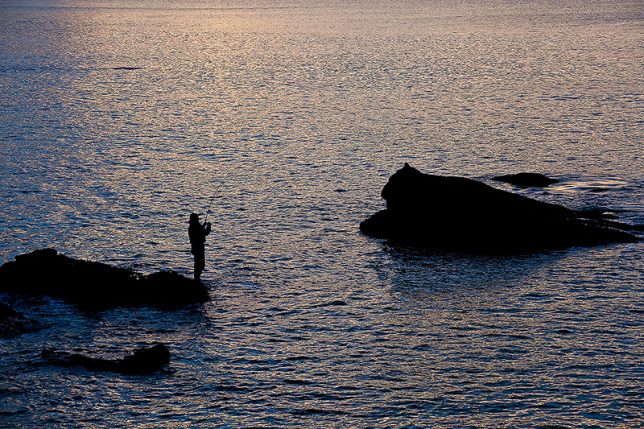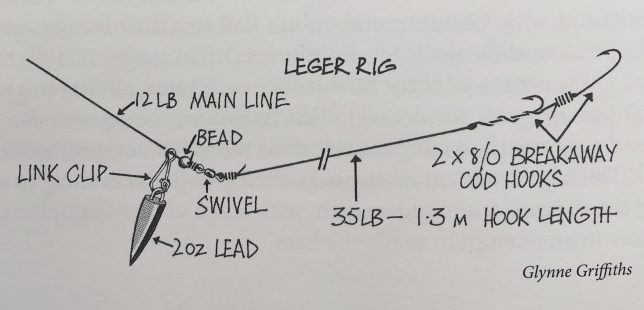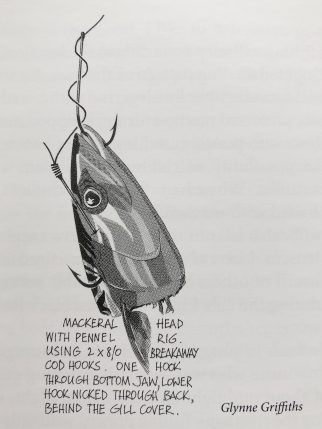CHAPTER 2 – TECHNIQUES – BAIT FISHING
River And Estuary Fishing For Bass
Ideas and views expressed here are based mainly on my personal experience on Sussex and Hampshire rivers, but the principles may apply elsewhere.
I have been a keen beach and boat angler for over twenty five years. Apart from occasional, accidental catches of bass beforehand I can clearly recall my first concerted efforts to regularly catch large bass. I took my inspiration from articles written by John Darling, I had a complete rethink of my marks, tides, bait and tackle, and started a quest to catch a 10-pound bass.

I avoided piers, and beaches where I had previously fished exclusively at high tide. Instead I began fishing beaches amongst rock ledges, and beaches subject to strong lateral flows. I now fished at dusk, dawn or throughout the night. The leger and paternoster rigs with size 2 Aberdeens were abandoned and replaced with simple rigs for use with large edible peelers, shore crabs, mackerel or sandeels, with hook sizes up to 8/0 used singly or as Pennell rigs.
My diary entries show almost instant success with regular bass to 8lb from various Sussex beaches. However, I remained frustrated that fishing my newly favoured beaches required a long drive, and even worse, heavy weed accumulations when I got there, causing many ruined sessions. I then attempted to catch big bass in local rivers, river harbours and river mouths. Fortunately success and constant results began immediately, with my first visit to a local mark producing a bass of 8lb 2oz, and five minutes from home! Further effort and research led me to confine most of my bass fishing trips to this and other local rivers which I had previously overlooked.
 I believe there are several considerations which may apply equally to rivers and estuaries around the country. Tackle can be much lighter (and correspondingly more sensitive) than open beach and rock situations would permit. Rivers are usually fishable in all weather conditions whereas beaches may fail in calm conditions or poor surf. Unlike beaches or rock marks, rivers may have several feeding periods throughout a tide, so you need to be mobile and have a planned approach to fishing various positions, with times for each. By contrast, beaches and rock marks tend to have one or two prime feeding periods when bass can be expected to pass a chosen location. Due to personal time constraints my average session length was 2-2 1/2 hours, which was ample because my consistent river marks are easily accessible without the need for long walks.
I believe there are several considerations which may apply equally to rivers and estuaries around the country. Tackle can be much lighter (and correspondingly more sensitive) than open beach and rock situations would permit. Rivers are usually fishable in all weather conditions whereas beaches may fail in calm conditions or poor surf. Unlike beaches or rock marks, rivers may have several feeding periods throughout a tide, so you need to be mobile and have a planned approach to fishing various positions, with times for each. By contrast, beaches and rock marks tend to have one or two prime feeding periods when bass can be expected to pass a chosen location. Due to personal time constraints my average session length was 2-2 1/2 hours, which was ample because my consistent river marks are easily accessible without the need for long walks.
I have now caught a reasonable number of bass to 9lb 14oz. During a two-week period I landed bass between 7lb 2oz and 9lb 14oz and lost many good-sized fish. Although the Sussex rivers can produce occasional bass to around 14lb, the average size is around 5lb, but fish of 1 to 3lb may take plugs, spinners or prawns. I usually fish at close range with freshwater and float leger rods, using 6 to 12lb mainline and light weights or bubble floats. When fishing at night I do not use a lamp or headlight, preferring a small pencil torch which is used sparingly. Natural background light or moonlight is usually sufficient to check the condition of bait or tangled plugs etc.
Time of year
In a normal Spring I believe that bass move into southern rivers in April and May. At this time of year large static baits such as crab, squid or mackerel are most productive when fished in harbours or the lower reaches. Between June and August, bass may be caught well into freshwater and will take maggot, bread, plugs, prawns, mackerel, squid and baited spinners. During September and October they move back down to the lower reaches and become concentrated there before moving out to the open sea.
Choosing marks
Each estuary is different, but most have solid structures controlling the flow of water with one main channel. I prefer to fish harbours at night coinciding with the first 2 or 3 hours of the flood. I like to fish from, or near to, an obstruction in the main channel which causes an area of slack water. This could be a pier, groyne, harbour wall, bridge pier etc. Other likely locations include changes in the course of the river such as bends and changes in sea wall features. Novices to river estuary fishing try to cast to the main channel in the belief that the fish are only there, but in my experience the majority of bass are caught in the margins of the tidal flow, in close proximity to the bank or structures in the tidal flow. These areas offer natural shelter for small fish and prawns – the food of bass. They also offer the opportunity to use light tackle which present less resistance to the tidal flow.
In one Sussex river the outward flow of the brackish river water at low tide is gradually engulfed by the rising flood tide. This produces a distinctive pattern of large ripples across the river. The appearance is akin to the wash of a passing boat. This period of disturbance is always greeted with a sense of anticipation, as I have often caught bass at this time, with fish to 9lb 14oz.
Bait
Stomach contents of bass caught in these areas suggest that they are hunting mainly for shore crabs and small fish. I have had no success with artificial methods in these situations and I rely on mackerel heads, with mackerel fillets and squid as second choice. I consider the presence of shore crabs and prawns essential when trying to locate a good river mark. My preferred river bass marks have an abundance of both, and fishing at such venues requires large baits which must be regularly changed. One half of a mackerel cut lengthways may last 15 minutes, and recovering a bait with 8 to 12 crabs feeding happily on it is not unusual, and must surely be attractive to any nearby bass.
Groundbait
It seems probable to me that the presence and activity of crabs actually attracts feeding bass. The crabs, while feeding, dismantle the bait and dislodge particles and juices which waft into the surrounding water and flow. Vibrations and sound from their clambering slurping throng may be a further inducement. I reuse old hookbaits chopped up with a few crushed crabs as groundbait. Several bass I have cleaned have contained items of this groundbait.

Methods
Methods of fishing will vary according to the location, prevailing conditions and the anticipated feeding pattern of the bass. An unusual method which I would not advocate is tight line legerlng with bread flake using quiver tip rod. This is my preferred method for thick-lipped mullet, but I have caught bass to 5lb 10oz with it. After catching a lot of bass with this method I take seriously the possibility of catching bass from a groundbaitcd swim intended for mullet. When I am fishing for mullet I therefore often use a second rod baited with mackerel.
Spinners will catch bass in rivers and I have caught small bass on baited Mepps and Jensens. I have observed medium-sized bass following spinners, and I have heard of others having reasonable success using Tobys fished from boats during the ebb. I have also used black Redgills for bass at night with success.
I had little faith in plugging but I was encouraged by fellow member Clinton Lambourne who was regularly catching on plugs. One session I recall was at about midnight on a dark calm night, when I had spent two hours walking the riverbank fishing prawns with only a schoolie to show for my efforts. I made up my mind to leave but my attention was drawn to a regular rise in a large area of slack water. On the second cast past it, the retrieve brought on a vicious take and the fish tore off downstream. This was my first bass on a plug and at 2lb 14oz not a large fish but very satisfying! The plug was a bronze and silver Rapala J11.
 Prawns and shrimps between 2 and 4cm can be fished sparingly or in small bunches on a size 2 carp hook. Most of my experience of using prawns and shrimps has been confined to twilight or the hours of darkness. It is essential to fish these midwater or on the surface, because anywhere near the bottom and they will be eagerly eaten by crabs and eels. I have needed to experiment with ways of keeping the float-fished bait within 3 meters of the riverbank in a fast flowing current. The solution was to use an 11 foot float rod with 12lb mono mainline tied to a 1oz weight, with a bubble float free to slide along the mainline; a 1.5m length of l0lb mono is attached to the other eye of the bubble float, as a trace, ending in a size 2 carp hook (see diagram for details. This technique works well, because prawns and shrimps invariably stay close to the week covered rocks of the riverbank. During calm evenings the bass often give their presence away by attacking the shrimps from underneath, with some of them jumping clear of the water in an attempt to evade the bass.
Prawns and shrimps between 2 and 4cm can be fished sparingly or in small bunches on a size 2 carp hook. Most of my experience of using prawns and shrimps has been confined to twilight or the hours of darkness. It is essential to fish these midwater or on the surface, because anywhere near the bottom and they will be eagerly eaten by crabs and eels. I have needed to experiment with ways of keeping the float-fished bait within 3 meters of the riverbank in a fast flowing current. The solution was to use an 11 foot float rod with 12lb mono mainline tied to a 1oz weight, with a bubble float free to slide along the mainline; a 1.5m length of l0lb mono is attached to the other eye of the bubble float, as a trace, ending in a size 2 carp hook (see diagram for details. This technique works well, because prawns and shrimps invariably stay close to the week covered rocks of the riverbank. During calm evenings the bass often give their presence away by attacking the shrimps from underneath, with some of them jumping clear of the water in an attempt to evade the bass.
 Large baits
Large baits
Large baits fished in spring or autumn have accounted for most of my larger bass. As a matter of preference I use frozen mackerel. Each one provides three baits – the head, and two full length fillets. Each of these baits is fished on a Pennell rig using 8/0 cod hooks tied to a 1.2m hook length of 35lb mono. The heavy hook length is essential to combat the chafing effects of crab’s claws as they feed on the bait. The basic rig is a running leger using a 1 or 2 oz lead to stop the bait from lifting in the current (see diagram). I use squid in the same manner, and for either bait I use shirring elastic to prevent the crabs from pulling the bait off the hook. My method of hooking the mackerel head is shown in the diagram.
In September and October I have taken bass to 8lb 6oz on pout livebait.
Experiences
Once, an evening trip to a local mark reinforced my need to experiment. I had agreed to take a friend’s two sons fishing. It was a warm July evening and I had decided to quivertip bread flake for mullet. The two youngsters were to fish with mackerel for silver eels using holiday rod and reel kits. Soon after we arrived we saw a sea trout of around 7lb cruising on the surface about 1 metre from the riverbank. I felt good and soon began to get confident mullet bites, so I settled down to some serious fishing. I left the lads with slivers of frozen mackerel on size 2 carp hooks.
I was concentrating on my rod when David, the eight year old, announced that he had a bite. I turned nonchalantly, expecting his rod to be twitching with a small eel or schoolie, but to my surprise and his obvious joy his rod was bent into an alarming curve! Line was emptying from the small spool against a tightly set and protesting clutch. I immediately slackened off the clutch and let him continue to play the unseen fish. I assumed he had a small bass of around 2 to 3lb. After a few minutes the reel was almost empty and the fish continued to stay deep with no sign of tiring. David was now complaining about his arms aching, so his older brother Daniel took over. I decided we must try and regain some line, and should therefore follow the fish downstream. At this point a swan, attracted by the commotion, decided to join in, and proceeded to entangle itself with the line, creating a three way contest. The struggle was now way beyond the design capabilities of the tackle and the strength of an eleven year old, so I took control of the rod and managed to free the swan.
I could now feel the full weight and power of the fish and realized that it was large. Reluctantly I gave the rod back and resigned myself to giving advice on when to wind and when to let the fish run. As we continued to move downstream, firstly 50 metres, then 100, it dawned on me that in my rush I had remembered to bring the landing net, but not the handle! I managed to get the fish to the upper layers and held the net as firmly as I could, but the fish veered away at the last moment and set off on another run.
About twenty minutes had passed and weed had now collected in a clump around the weight. Stalemate had been reached with the combined weight of bass and weed, making any progress against the current impossible. A further move downstream to get in line with the fish was needed, and with that I once again took control of matters. The bass was now closer to the bank, although still well out of reach. I applied minimal pressure to guide the fish in, then suddenly the weight and movement of the fish was gone. I felt immediately that crushing pang of anguish which all anglers go through at some point in their angling life; that moment when one instinctively knows that something has gone drastically wrong, your quarry has escaped, and you will never know how heavy it was.
I broke the news to the two boys, who had stayed well upstream at that time, and I was surprised at the reaction – utter devastation and despair. These things happen, and a lesson was learnt the hard way and never forgotten to this day. Be prepared and adaptable, and don’t forget essential items of kit!
The fish I estimated at 9lb 8oz, judged against the size of the landing net and other fish from the same river.
Author: Tony Lee
Historical note: This article was published in BASS magazine no.82 May 1997
© Bass Anglers’ Sportfishing Society 2008